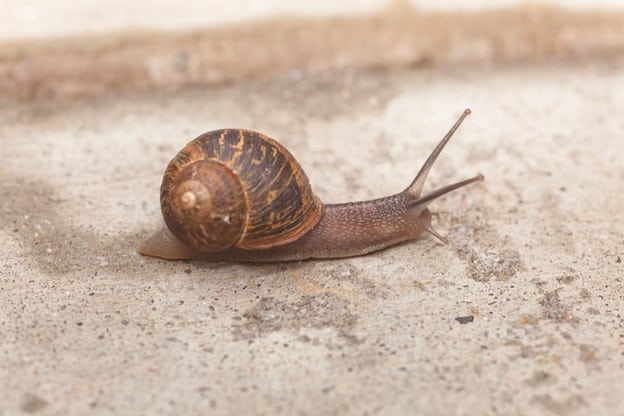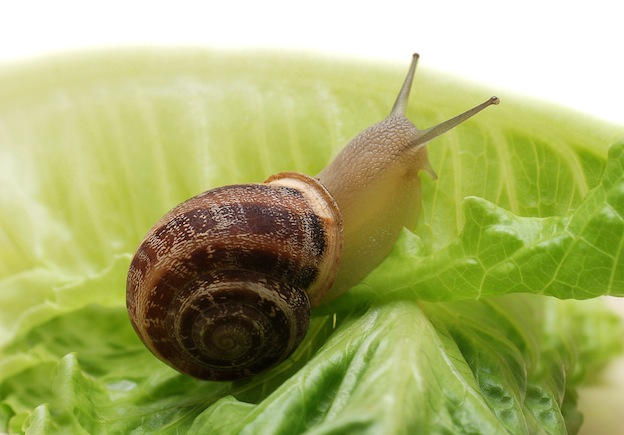Garden Snail – Helix aspersa
Description
The garden snail (helix aspersa) is one of the best-known species of snails in the world. As all terrestrial snails is a gastropod mollusk. It is so common, that it is one of the most proliferated terrestrial mollusks.
The helix aspersa is also known with the common name of “European Brown Garden Snail”, but its scientific name is has alternative versions. Some scientist name this snail as Cornu aspersum, Cantareus aspersus or Cryptomphalus aspersus.
This species is native of Europe but it has been introduced in several parts of the world where it has become a pest for crops and gardens.
Anatomy
The Helix aspersa is an air-breathing snail, which has a single lung. They have a brownish soft body, which is usually covered with slimy mucus.
They have yellow or cream-colored shells with brown spiral stripes. When a snail is old enough, a lip is formed at the edge of the shell aperture. The shell of this species has a height of about 1-1.4 inches and a width of 1-1.5 inches.
The garden snail has a flat muscular organ called a foot that helps it move with a gliding motion helped by the release of a mucus to reduce friction with the rough surface.
This mucus is the reason why snails leave a wet trace of slime when they move around.

Garden Snail or Helix aspersa
Behavior
Garden snails are mainly active during nights or early mornings when the sun is not shinning, however they can be active during cloudy or rainy days.
Some Helix aspersa hibernate during winter months, especially when they are mature, but they return to activity with the spring.
They are extremely slow as their fastest speed is only 1.3 centimeters per second.
Habitat and Distribution
The Helix aspersa was originally found in the British islands, western Europe and the Mediterraneo, reaching some regions of north Africa, and the middle east.
However, this snail has been introduced to several places where they have become agricultural pests. These places include the United States, Canada, South Africa, Australia, New Zealand, Mexico, Chile, Argentina and some others. This snail has arrived to these places either by accidentally hidden in plant or vegetable shipments or intentionally imported for some purpose.
Diet and Feeding Habits
Garden snails are herbivorous and feed on several kinds of fruit trees, garden plants, crop vegetables and some cereals.
Snail mouth is beneath its tentacles and it has a toothed ribbon called the radula, which is used to fragment its food. This structure is exclusive of mollusks and most of them have one.

Close up to garden snail on green background
Reproduction
Like other gastropod mollusks, the Helix aspersa is hermaphrodite; this means that it has both male and female organs. However, mating is required for fertilization, even tough self-fertilization is possible for this species.
The mating process is complex and interesting. After some pairing and courtship, this species start the mating process that can last from four to twelve hours and usually includes the exchange of a love dart, a kind of calcareous arrow with a purpose still unclear.
During the mating process they fertilize each other and they both will lay around 80 eggs 3 to 6 days after the mating occurs. To deliver his eggs, each snail will create a nest digging a hole in the soil with its foot. The nest will be 1 to 1.5 inches deep where the eggs will be delivered.
Gardens snails are able to deliver up to six batches of eggs in a single year. Each newborn, will take one to two years to mature.
Predators
Garden snails are food source for some animals like lizards, frogs and worms. Predatory insects and other species of snails will also eat garden snails.
Some birds, especially ducks will feed on these snails.
Relation with humans
This species is edible and it is sometimes used for cooking, although it should not be confused with the helix pomatia, the “Escargot”.
Although is considered a pest in most places, it has acquired popularity in the cosmetic industry because the regenerative properties of their mucus.
http://www.arkive.org/garden-snail/helix-aspersa/
http://entnemdept.ufl.edu/creatures/misc/gastro/brown_garden_snail.htm
http://www.ipm.ucdavis.edu/PMG/r107500111.html
http://en.wikipedia.org/wiki/Helix_aspersa
Sem comentários:
Enviar um comentário